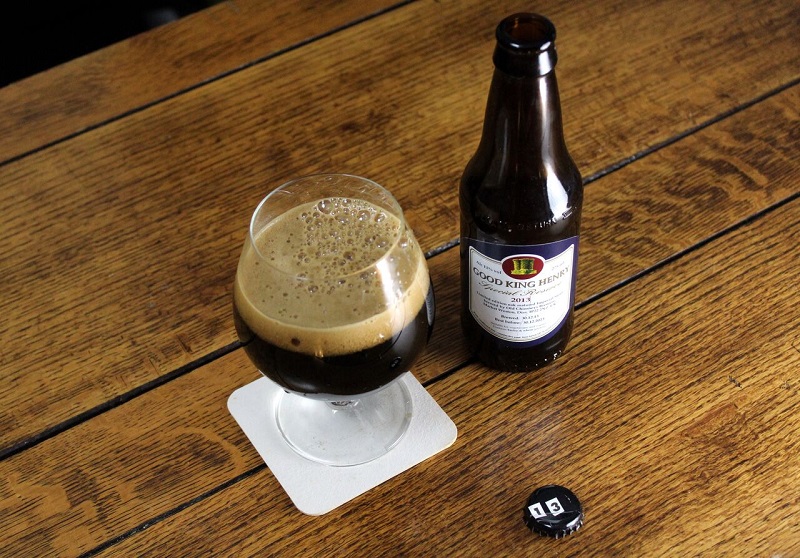The Mystery of Old Chimneys

(Photo by Boak and Bailey)
There is only one British beer in RateBeer’s top 50 chart—Old Chimneys Good King Henry Special Reserve imperial stout—which, as far as some people are concerned, makes it The Best Beer in Britain.
But here’s the wrinkle: hardly any British drinkers have heard of it, let alone tasted it. An informal poll conducted via Twitter in February revealed that, of the 264 people who responded, only about half were aware of the brewery at all and only around 20 percent had ever tasted any of their beers. (And bear in mind that our Twitter followers are by definition ‘beer people’.) Nor has it ever placed in the Campaign for Real Ale’s annual champion bottled beer of Britain competition.
So how did Old Chimney’s Good King Henry Special Reserve (GKHSR) gain its lofty reputation? The answer lies in large part with one super fan and in the dynamics of beer rating communities.
Alan Thomson, Old Chimneys’ founder, is 60 and has been working as a brewer for almost 40 years. Having graduated with a degree in biochemistry, in 1977 he got a job with Vaux, a large brewery in the North East of England, where he worked until the mid-1990s in, as he puts it, “the mainstream of brewing.” In 1995 he moved to the East Anglian county of Suffolk and set up his own small brewery primarily producing cask-conditioned beer for the local pub market. Thomson is as bewildered by GKHSR’s rise to global acclaim as anyone else: “I wanted to escape from the rat race, not get back into it!”
His head-scratching confusion is only compounded by the circumstances in which this particular beer came to be.
“I first brewed Good King Henry, the normal version, in 2000,” Thomson says. “It was already a strong beer at 9.6% made with a fairly high proportion of malt extract to get up to that strength. I don’t know if I should say this but. … The first batch of Special Reserve was the result of a cock-up in 2002. I miscalculated and added too much malt extract.”
It then occurred to Thomson that an 11% beer might be just the thing to celebrate the brewery’s upcoming 10th anniversary. He threw in some winemakers’ oak chips and left it to mature for six months before bottling and then left it alone. When he came to taste it in late 2004 he was delighted to find that it had come good: “I thought, ‘Ooh, hold on, that’s absolutely beautiful. … I’m on to something here.’” Thomson brewed a second batch while the first batch was sold to local drinkers over Christmas 2004.
So far, so ordinary. What happened next, however, is that it began to escape from Suffolk. Some bottles were sold at the 2006 East London beer festival run by the Campaign for Real Ale, with bottled beers sourced by festival organiser Keen Massey. It is an event heavily attended by ‘tickers’ and RateBeerians, as users of the site are known, and the first handful of RateBeer reviews are all traceable to this event. That’s also where RateBeerian Chris Owen bought bottles for his stash, only he went a step further: in the summer of 2007 he took them on a transAtlantic trip to a RateBeer summer gathering in the U.S. “There weren’t too many U.K. imperial stouts around in those days,” Owen wrote in an email, “and since it’s better to take a ‘big beer’ to that sort of event rather than some bottled bitter or the like which in all probability wouldn’t come across too well, I guess it was a bit of a no brainer.”
There, drinkers not only from the U.S. but from all around the world had the opportunity to try a beer that had an added mystique because Thomson made so little effort to market it: “Apparently the only way to get this beer is to trek to the brewery and basically get it from the hand of the brewer himself,” wrote user ‘badgerben’ in his 2007 review. This was essentially true. Even today, there is no email address given on the Old Chimney’s website and Thomson did not, at that time, dispatch beer by mail order.

Craig Garvie (Photo by Janine Shorrock)
The flurry of high rankings that followed that summer gathering—most awarding 18, 19 or 20 out of 20 and accompanied by profuse thanks to ‘Chris_O’—put the beer into the Top 50 chart. That might have been a blip except those events brought it to the attention of Edinburgh beer lover Craig Garvie. He is an enthusiastic character often to be seen at beer festival in a colorful bowler hat, steampunk shades and with his beard dyed one colorful shade or another. A particular fan of strong stouts, he knew he had to get his hands on GKHSR.
“I phoned up the brewery and basically begged [Thomson] to sell me some,” Garvie says. “He wasn’t doing mail order then but I said I’d take all the risk, pay whatever he wanted. That first order was for 24 bottles, 12 of the Special Reserve, six standard and six of his other beers.”
Garvie was to become one of the key players in the further spread of GKHSR.
“Because it was rare to everyone but me, because I had a lot of it, I kind of handed it out to anyone that wanted it,” Garvie says. “Like, my postman got a bottle, and if someone at work said it was their husband’s 50th birthday I’d say, ‘Do they like beer?’ and they’d get one.
Garvie acknowledges, however, that his motives were not purely altruistic: “I was doing a lot of trading on RateBeer and was suddenly able to trade it for other rare things with people in the U.S.,” he says.
He has been buying GKHSR by the case, sometimes more, sometimes less, every year since, and either trading or giving much of it away. As another RateBeer user, Andrew Drinkwater, says, Garvie is “effectively their international distribution arm … posting bottles to people who are almost certain to rate it highly.” Though he is not the only person to have shared bottles of GKHSR Garvie remains perhaps its most vocal hypeman on social media, organizing social tastings in Scotland and elsewhere and writing many, many reviews on RateBeer of each bottle he has drunk. “It’s definitely the beer I drink most of—maybe eight bottles a year or something like that,” he says – an unusual tally for someone with what he calls a “RateBeer problem” normally compelled to seek fresh “rates” over familiar beers.
Does the beer deserve its consistent place in the top 50 beers and its status as RateBeer’s top English beer? It is generally felt that RateBeer has a bias towards scarce beers such as Westvleteren XII, and towards imperial stouts in particular. Writer Bryan Roth (a regular contributor to All About Beer Magazine) has conducted extensive number-crunching on RateBeer data and in a 2013 post on his blog This is Why I’m Drunk observed that: “More often than not [imperial stouts] are limited release, limited distribution and well hyped. It’s a perfect storm.”
Even Garvie, devotee that he is, acknowledges that there are other strong British stouts that are just as good. Nonetheless, he says, if it wasn’t a fundamentally good beer, whatever the hype around it, the ratings would eventually drop off. They haven’t.
“It has been in the top 50 for a long time which is not true of many beers,” Garvie says. “I can think of a few that were there when I started and have gone. One of the problems of RateBeer is that you do get fads for certain breweries but Old Chimneys hasn’t been like that. It’s never been impossible to get hold of and it is a great beer so I don’t think it lets people down, it doesn’t disappoint.”
Others we spoke to said the same thing: its fame might be a quirk of the way RateBeer functions but the praise is not undeserved. We tasted a bottle of the 2013 brew supplied by Garvie from his personal stash. It is a dense, luscious beer with an intense dessert-wine sweetness and an undercurrent of beef and bitterness. There are other beers that taste similar—Prince of Denmark, a 7.5% stout brewed by Harvey’s of Lewes for example—but, based on this brief encounter, GKHSR is no fraud.
For his part, Thomson has mixed feelings, saying, in his quiet way, “I find the idea of having a worldwide following a bit odd and I can honestly say it’s not what I had planned. Sometimes I do wish it had never happened, when all hell breaks loose every autumn with people trying to get hold of the beer. I get phone calls from everywhere, all round the world, not just America. I ask myself, ‘Why am I doing this?’”
He is personally more fond of another beer he brews—an 11.4% oak-aged ale called Red Admiral—not least because, unlike GKHSR, it was executed as planned: “I suppose I’ve always felt a bit resentful that my best-known beer is the result of making the best of a balls-up so, from a professional point of view, Red Admiral is much more satisfying.”
Boak & Bailey have been blogging at boakandbailey.com since 2007. They were named 2014 beer writers of the year by the British Guild of Beer Writers for Brew Britannia: The Strange Rebirth of British Beer. They live in Cornwall in the far west of the U.K.

I have ventured out to the brewery about three maybe four times but since the last stock on EeBria it’s no longer assurance that they have it on site.
It was the fastest-selling beer online in the UK at the time. I have personally taken the beer to Maine and Massachusetts as well as The Netherlands and Belgium. It used to be my gift to brewers.
It’s a special beer and deserves every accolade. Alan’s extremely humble in person and very accommodating.
Hey Thomas! If you ever get any of the King Henry and you’re coming to Maine, let me know! Kate Cone
Thomas,
If you are still out there and getting this beer please message me on BA. BeerRay
I’m in RI and would be interested in a share with some top beers if you are.
Cheers!
If you look on Untappd you will see that there are many people from across the world that have tasted and heard of Old Chimneys. Top rated English brewery on Untappd
Rate Beer us not the only beer social media site. If you looked at e.g. Untappd you would see that OCB is well known globally and there are plenty of people who have rated GKHSR highly
Thomas,
If you are still out there and getting this beer please message me on BA. BeerRay
I’m in RI and would be interested in a share with some top beers if you are.
Cheers!